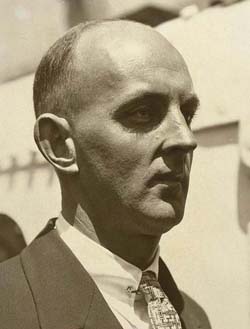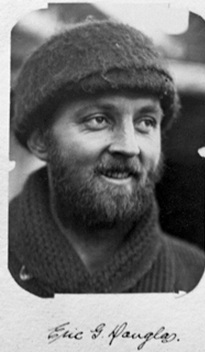
Known
as Eric, Gilbert Eric Douglas (1902-1970), air force officer, was born on 6
December 1902 at Parkville, Melbourne, second son of Gilbert Douglas,
watchman, and his wife Bessie, née Thompson, both Victorian born.
Educated at Swinburne Technical College, Eric served three years in the
senior cadets before joining the Australian Air Corps in November 1920.
He enlisted in the (Royal) Australian Air Force on 31 March 1921 as an
aircraftman class 2, fitter aero, and gave his religion as Methodist.
Douglas's early postings were to No.1 Flying Training School, Point Cook
(1921 and 1922-29), and No.1 Aircraft Depot, Laverton (1921-22). He
graduated as airman pilot on 1 December 1927 and was promoted
substantive sergeant in October next year.
On 22 November 1922 Douglas had been front-seat passenger in an Avro
504K which attempted to land at Mascot, Sydney. Realizing that the
aircraft was about to hit a fence, he stood up: the crash 'propelled him
forward' and he was found 'squatted astride the crankshaft, unconscious
and bleeding', when the plane came to rest. His quick reaction had saved
his life. In 1928, while he was passenger in a test-flight of the
Warrigal I, the pilot was unable to recover from a spin. Ordered to
abandon the aircraft, Douglas got to his feet: his tall, spare frame
'apparently varied the air flow over the tail', enabling the pilot to
regain control and Douglas to resume his seat.
In April 1929 he flew a D.H.9A to the Northern Territory to join
Charles Eaton's team in the search for the ill-fated crew of the
Kookaburra, Keith Anderson and Bob Hitchcock. Douglas was one of the
ground party which left Wave Hill on the 24th and reached the
Kookaburra's forced-landing site in the Tanami Desert. He helped to
bury Anderson and Hitchcock, and was recommended for the Air Force Medal
for his part in the mission. On 1 August he was promoted pilot officer.
 Following the decision to equip the British, Australian and New
Zealand Antarctic Research Expedition with a Gipsy Moth seaplane,
Douglas and Flying Officer Stuart Campbell were selected to accompany
the explorers on their polar voyage in the summer of 1929-30. The pilots
made reconnaissance flights and guided the ship, Discovery,
through the ice. Because of his mechanical knowledge, Douglas had prime
responsibility for maintenance of the aircraft. The expedition's leader
Sir Douglas Mawson also took the Moth and its pilots on the second
B.A.N.Z.A.R.E. (1930-31). A flight by Douglas and Mawson on 27 January
1931 almost ended fatally due to a mishap when the plane was being
hoisted on board Discovery. In 1934 Douglas was awarded the Polar
Medal.
Following the decision to equip the British, Australian and New
Zealand Antarctic Research Expedition with a Gipsy Moth seaplane,
Douglas and Flying Officer Stuart Campbell were selected to accompany
the explorers on their polar voyage in the summer of 1929-30. The pilots
made reconnaissance flights and guided the ship, Discovery,
through the ice. Because of his mechanical knowledge, Douglas had prime
responsibility for maintenance of the aircraft. The expedition's leader
Sir Douglas Mawson also took the Moth and its pilots on the second
B.A.N.Z.A.R.E. (1930-31). A flight by Douglas and Mawson on 27 January
1931 almost ended fatally due to a mishap when the plane was being
hoisted on board Discovery. In 1934 Douglas was awarded the Polar
Medal.
From May 1931 Douglas performed instructional duties at No.1 Flying
Training School. On 6 January 1934 he married Ella Sevior at Christ
Church, South Yarra, with Anglican rites. Promoted flight lieutenant in
July, he commanded the R.A.A.F. contingent in Discovery II which
sailed in December 1935 for the Bay of Wales, Antarctica, to search for
the American explorer Lincoln Ellsworth and his pilot Herbert Hollick-Kenyon.
On 15 January 1936 Douglas flew over the United States' base, Little
America, and sighted Hollick-Kenyon. Both men were safe and Ellsworth
made the return trip to Melbourne in Discovery II. He and Douglas
became close friends; Douglas named his son Ian Ellsworth.
Transferring to engineering duties in June 1937, Douglas returned to
No.1 Aircraft Depot in command of the Technical Squadron's aircraft
repair section. By July next year he was back at No.1 F.T.S. as engineer
officer. He introduced sailing as a recreational activity for cadets and
test-flew aircraft when required. Promoted temporary wing commander, in
June 1940 he assumed command of No.1 A.D. In June 1942 he moved to
Queensland to command No.3 A.D. at Amberley where he was responsible for
servicing aircraft of the Australian and U.S. air forces. On 1 December
1943 he was promoted temporary group captain and in August 1947 became
commanding officer of R.A.A.F. Station, Amberley. He retired on 1 July
1948 in the rank of group captain.
In 1949-60 Douglas was a civilian technician with the navy's Aircraft
Maintenance and Repair Division, Melbourne. Survived by his wife, son
and two daughters, he died of cardiac disease on 4 August 1970 at
Heidelberg and was cremated.
Source: Australian Dictionary of Biography
Father: Gabriel (Gilbert) Douglas, b. 3 Oct 1869, Victoria,


